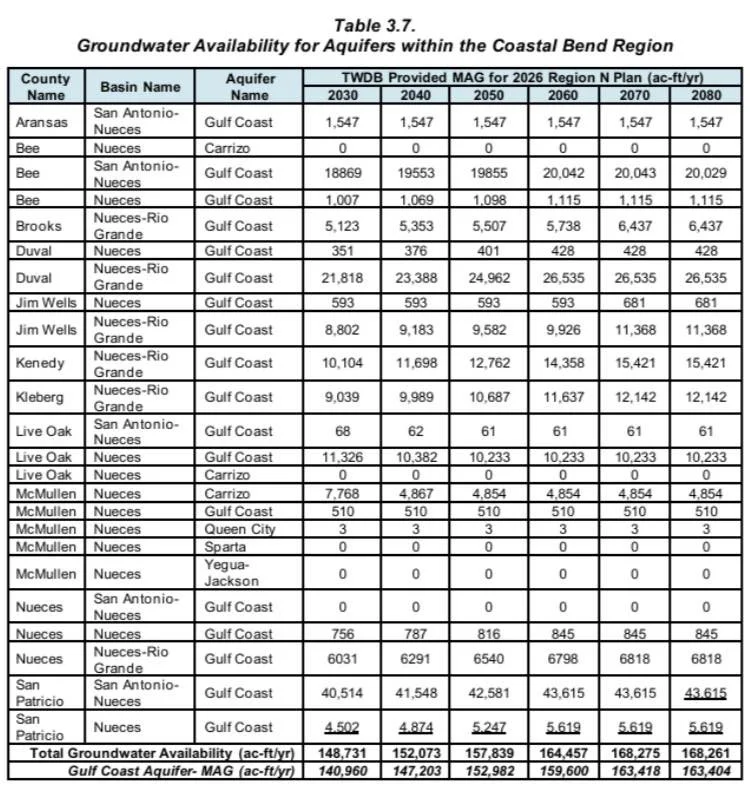Understanding Groundwater Availability in the Coastal Bend Region
What the Data Means for the Nueces Aquifer
In Texas, the Texas Water Development Board (TWDB) plays a crucial role in ensuring our state’s water resources are responsibly managed for both present and future generations. One of the most important tools in this process is the Modeled Available Groundwater (MAG) — the amount of groundwater the state determines can be pumped each year while still meeting the region’s Desired Future Conditions (DFCs).
In other words, the MAG represents a balance point — the amount we can safely withdraw without depleting our aquifers or harming long-term water availability.
The Nueces Aquifer and the 2026 Region N Water Plan
The table above, pulled from the 2026 Region N Water Plan, shows the projected groundwater availability for aquifers across the Coastal Bend Region from 2030 through 2080. Among the most significant aquifers in this region are the Gulf Coast, Carrizo, and Queen City, which collectively serve counties like Nueces, Bee, Jim Wells, and Kleberg.
For Nueces County, the state has determined that the total Modeled Available Groundwater (MAG) is 6,787 acre-feet per year, or roughly 2.21 billion gallons of water annually.
This allocation reflects the amount that can be withdrawn from the Gulf Coast Aquifer system within Nueces County while still sustaining the long-term health of the aquifer and meeting the Desired Future Conditions established by regional water planners.
Why This Matters
Understanding and respecting the MAG is essential to maintaining the delicate balance between growth and conservation. When withdrawals exceed the modeled available groundwater, the result can be:
Lowered water tables, affecting wells and landowners.
Reduced spring flows, which impact ecosystems and wildlife.
Increased salinity, threatening freshwater supplies and coastal habitats.
By managing withdrawals within the MAG, the Nueces Groundwater Conservation District helps protect the Nueces River Basin, ensuring that both rural communities and urban centers like Corpus Christi have a sustainable supply of groundwater for decades to come.
A Regional Effort in Conservation
Groundwater doesn’t stop at county lines. The Coastal Bend’s aquifer systems — particularly the Gulf Coast and Nueces–Rio Grande formations — serve multiple counties across the region. That’s why collaboration between water districts, landowners, and municipalities is vital.
Each district plays a role in monitoring usage, educating residents, and developing conservation strategies tailored to local needs. For Nueces County, this means continued dedication to protecting recharge zones, monitoring salinity levels, and advocating responsible groundwater use.
In Summary
The 6,787 acre-feet per year (2.21 billion gallons) allocation for Nueces County is more than just a number — it’s a benchmark for responsible stewardship. The MAG ensures that we balance today’s water needs with tomorrow’s sustainability, protecting both people and the natural systems that depend on our shared groundwater resources.
Together, we can ensure the Nueces Aquifer remains a reliable source of life, livelihood, and legacy for generations to come.

